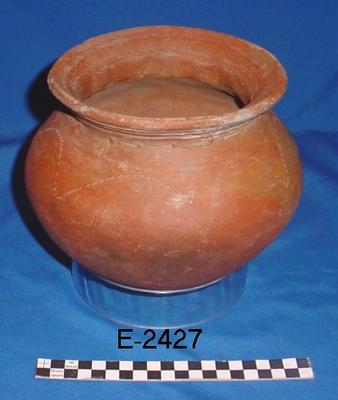Pottery
Production date
Unknown
Country
Papua New Guinea
State/Province
Madang
See full details
Object detail
Description
Earthenware cooking pot - BODI: Restricted composite vessel with a rounded base, spherical belly and a corner point forming a sharp-angled shoulder.
Classification
INDIGENOUS CULTURES Melanesian & South Sea Islander pottery
Maker
Production date
Unknown
Production place
Measurements
H.190 x Dia.225 mm
Media/Materials description
Earthenware
History and use
Bodi, a common Yabob cooking pot is a restricted composite vessel with a rounded base, spherical belly and a corner point forming a sharp-angled shoulder. The short neck precedes the everted rim which is slightly thicker than the walls of the pot, with three or four ridges underneath it on the outside and a definite ridge on the inside.
The Yabob and Bilbil people of Madang province hold the traditional pot making rights along the coastal area. Women who marry into another village may not make pots as it is considered taboo, regardless if there are suitable clay deposits nearby. Conversely, women who marry into Yabob-Bilbil may learn to make pots there.
Yabob women usually collect clay from designated areas, working them into large balls and carrying it back to the village. Yabob clay is stored under the houses and kept moist with damp bags. Clay preparation takes place in three stages. Initially, beach sand was sprinkled on to a traditional board and the softened clay was pounded until almost paper thin, with sand added during the process. The sheets of clay are then soaked until soft enough to be squeezed through the fingers. Any uncrushed grit was discarded and the clay was drained on piles of sand. However, with exposure to foreign methods, the Yabob potters have dispensed with the pounding stage and now soak the clay in drums, sieve the clay into another drum through wooden-framed sieves and then place it onto piles of sand to drain.
Three tools are used at Yabob: anvils, paddles and decorating tools. The anvils are smooth round river stones called piti, believed to possess magical properties that drive out evil spirits from the clay and are prized possessions handed down by the women to their daughters-in-law following their initiation into pot making. Three kinds of paddles are used: darib has a rough, naturally ridged surface, hohoi is narrow and very smooth and the dardral is wider, flat and smooth. Small tools for decoration and making the ridges under the rims of the pots are made from black palm, split bamboo or stems of grass shaped to a fine point for incising or rounded for ridge making.
Completed pots are stored under the house until they have turned a yellowish colour or a dull gray, depending on the type of clay. They are then dried in the sun for a time before a clay slip, mein, is applied which fires a redder colour than the clay of the pot and helps seal the surface. Mein is made from a dark yellow fine-grained clay which is soaked in water, stirred and then applied to the pot with a piece of fibrous coconut husk. Once dried, the pot is fired and then made ready for use. Traditionally, before a cooking pot can be used it must be covered with the blood of a pig.
The Yabob and Bilbil people of Madang province hold the traditional pot making rights along the coastal area. Women who marry into another village may not make pots as it is considered taboo, regardless if there are suitable clay deposits nearby. Conversely, women who marry into Yabob-Bilbil may learn to make pots there.
Yabob women usually collect clay from designated areas, working them into large balls and carrying it back to the village. Yabob clay is stored under the houses and kept moist with damp bags. Clay preparation takes place in three stages. Initially, beach sand was sprinkled on to a traditional board and the softened clay was pounded until almost paper thin, with sand added during the process. The sheets of clay are then soaked until soft enough to be squeezed through the fingers. Any uncrushed grit was discarded and the clay was drained on piles of sand. However, with exposure to foreign methods, the Yabob potters have dispensed with the pounding stage and now soak the clay in drums, sieve the clay into another drum through wooden-framed sieves and then place it onto piles of sand to drain.
Three tools are used at Yabob: anvils, paddles and decorating tools. The anvils are smooth round river stones called piti, believed to possess magical properties that drive out evil spirits from the clay and are prized possessions handed down by the women to their daughters-in-law following their initiation into pot making. Three kinds of paddles are used: darib has a rough, naturally ridged surface, hohoi is narrow and very smooth and the dardral is wider, flat and smooth. Small tools for decoration and making the ridges under the rims of the pots are made from black palm, split bamboo or stems of grass shaped to a fine point for incising or rounded for ridge making.
Completed pots are stored under the house until they have turned a yellowish colour or a dull gray, depending on the type of clay. They are then dried in the sun for a time before a clay slip, mein, is applied which fires a redder colour than the clay of the pot and helps seal the surface. Mein is made from a dark yellow fine-grained clay which is soaked in water, stirred and then applied to the pot with a piece of fibrous coconut husk. Once dried, the pot is fired and then made ready for use. Traditionally, before a cooking pot can be used it must be covered with the blood of a pig.
Registration number
E2427



